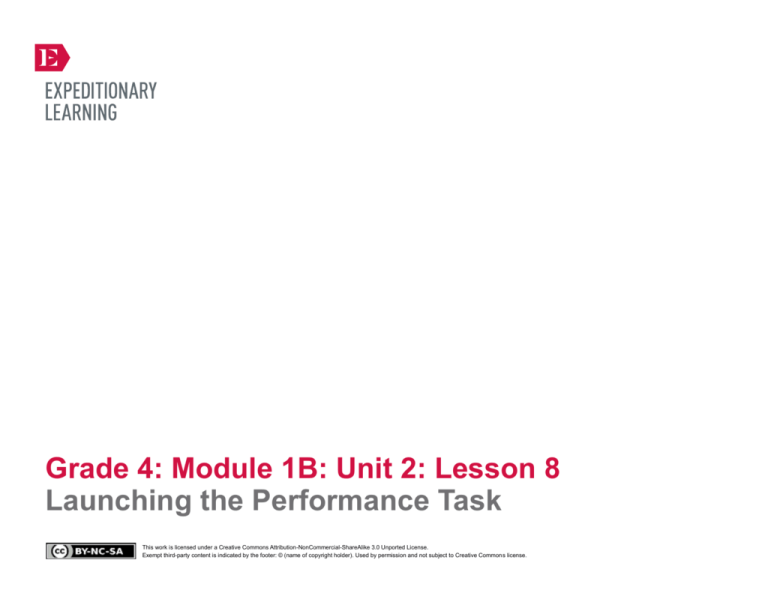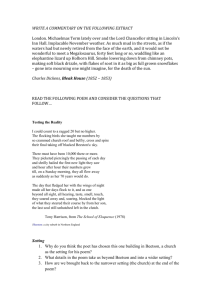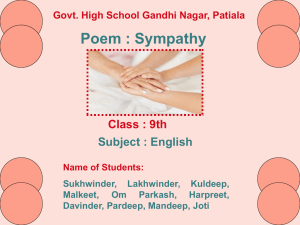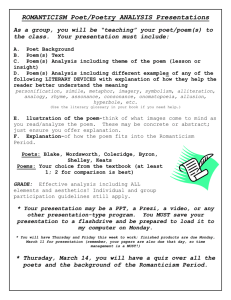
Grade 4: Module 1B: Unit 2: Lesson 8
Launching the Performance Task
This work is licensed under a Creative Commons Attribution-NonCommercial-ShareAlike 3.0 Unported License.
Exempt third-party content is indicated by the footer: © (name of copyright holder). Used by permission and not subject to Creative Commons license.
GRADE 4: MODULE 1B: UNIT 2: LESSON 8
Launching the Performance Task
Long-Term Targets Addressed (Based on NYSP12 ELA CCLS)
I can explain what a text says, using specific details from the text. (RI.4.1)
I can use literary terms to describe parts of a story, poem, or drama (e.g., verse, rhythm, meter, casts of characters, settings, descriptions, dialogue, stage directions).
(RL.4.5)
Supporting Learning Targets
Ongoing Assessment
• I can synthesize my understanding of the What Makes a Poem a Poem? by describing the characteristics
of poetry.
• Poetry journal
• I can choose a poet to study whose poems inspire me as a writer.
Copyright © 2013 by Expeditionary Learning, New York, NY. All Rights Reserved.
NYS Common Core ELA Curriculum • G4:M1B:U2:L8 • June 2014 •
1
GRADE 4: MODULE 1B: UNIT 2: LESSON 8
Launching the Performance Task
Agenda
Teaching Notes
1. Opening
• This lesson serves as a transition between the first half of the module (reading and analyzing Love That
Dog) and the second half of the module (studying a poet and his/her poems).
A. Engaging the Reader: Revisiting “What Makes a
Poem a Poem?” (10 minutes)
B. Reviewing Learning Targets (5 minutes)
2. Work Time
A. Introducing the Performance Task (10 minutes)
B. Reading New Poems to Select a Poet (25 minutes)
3. Closing and Assessment
A. Selecting a Poet (10 minutes)
4. Homework
A. Look back in Love That Dog and reread the poem
from Unit 1 by your selected poet and review the
notes in your reader’s notebook about this poem.
B. Reread the poem from Unit 1 written by your
selected poet.
• During the Closing, students choose a poet they wish to study for the remainder of the module. Students
will have the choice to select from the following poets: Robert Frost, Walter Dean Myers, and Valerie
Worth (Note: two other poets whose poems students read in Unit 1 – William Carlos Williams and
Arnold Adoff – will be used for whole class modeling purposes in Unit 3. Therefore, these two poets are
not provided as options for students to select).
• It is important to allow students to make this choice as freely as possible, so they can connect with the
second guiding question for this module (“What inspires writers to write poetry?”). Students eventually
will write original poems inspired by the poet whom they choose to study. In subsequent lessons in
Units 2 and 3, students will work in small “poet groups,” base on the poet whom they have selected. If
there is just one student who selects a particular poet, use your professional judgment on the best
options for this student. (For example, guide this student to select another poet s/he enjoys equally;
have this student work with another poet group in future lessons but still focus on his or her own poet;
or have this meet with a teacher or instructional aid consistently for additional support throughout the
remainder of the module.)
• During Work Time B, all students read a selection of new poems by the three selected poets, in order to
get more of a sense of each poet’s styles and techniques. They then choose a poet, and will closely read
and analyze just that one poet’s poem in Lesson 9. Preview Lesson 9 to envision this arc of instruction.
• During Work Time B, students participate in a modified version of the Four Corners protocol. Instead of
using four corners, students will only select from three corners of the room: one corner for each of the
three poets offered as a choice for the performance task.
• In advance:
– Display the What Makes a Poem a Poem? anchor chart and Frayer Model—Poetry
– Prepare the new Performance Task anchor chart.
– Review: Milling to Music Checking for Understanding technique and the Four Corners protocol (see
Appendix).
Copyright © 2013 by Expeditionary Learning, New York, NY. All Rights Reserved.
NYS Common Core ELA Curriculum • G4:M1B:U2:L8 • June 2014 •
2
GRADE 4: MODULE 1B: UNIT 2: LESSON 8
Launching the Performance Task
Lesson Vocabulary
Materials
Structure, features, poetry, experience,
emotion, synthesize
• What Makes a Poem a Poem? anchor chart (from Unit 1, Lesson 2)
• Frayer Model—Poetry (from Lesson 3)
• Performance Task anchor chart (new; teacher-created)
• “safety pin” by Valerie Worth (one per student)
• “Lawrence Hamm, 19 Student Athlete” by Walter Dean Myers (one per student):
• “A Patch of Old Snow” by Robert Frost (one per student):
• Poetry journals (students’ own; from Unit 1)
• Reader’s notebook (students’ own; from Unit 1)
Meeting Students’ Needs
Opening
A. Engaging the Reader: Revisiting “What Makes a Poem a Poem?” (10 minutes)
• Congratulate students on completing their reading of Love That Dog and the Mid-Unit 2 Assessment.
• Explain to students that before they move into the next half of the unit, they will revisit the guiding question:
* “What makes a poem a poem?”
• Display the What Makes a Poem a Poem? anchor chart (from Unit 1, Lesson 2) and the Frayer Model—Poetry
from Lesson 3. Tell students that they will use these charts to help them synthesize their understanding of what poetry is.
• Ask students to read over the What Makes a Poem a Poem? anchor chart and the Frayer Model—Poetry. Ask students to turn
and talk with a partner about the following question:
* Based on our new learning, is there anything from the anchor chart that you would like to add to our Frayer Model?”
• Call on pairs and add student observations as necessary.
• Point out that the characteristics on the Frayer Model have to do with the structure and features of poetry, and that there is
another really important aspect of poetry to explore: the meaning. Poets write poems to express something important; they
just choose poetry as their preferred way to share. Tell students that today, the class will be thinking about the meaning of
poems and how poems affect both the people who write them and the people who read them.
Copyright © 2013 by Expeditionary Learning, New York, NY. All Rights Reserved.
NYS Common Core ELA Curriculum • G4:M1B:U2:L8 • June 2014 •
3
GRADE 4: MODULE 1B: UNIT 2: LESSON 8
Launching the Performance Task
Meeting Students’ Needs
Opening (continued)
• Remind students of Jack’s poem “My Sky.” Invite students to turn and talk. Ask:
* “Why did Jack write this poem?”
• Refocus students for a full group discussion. Ask them to think about Jack’s poem and the other poems they have read and
discuss this question: “What are some reasons poets write poems?”
• Cold call students to share what they talked about with their partner. Listen for responses such as: “Poems can tell about
important things you experience and how you feel.”
• Invite students to turn to page 73 of Love That Dog and point out the following line: “If you put it on the board and people
read it, it might make them sad.”
• Invite students to turn and talk. Ask:
* “Based on what Jack says, what has he learned about poetry?”
• Cold call students to share what they talked about with their partner. Listen for responses such as: “Poems can make you feel
things.”
• Explain that this is an important characteristic of poetry—that poets often write poems to share experiences and to make
their readers feel an emotion. Tell students that poets do this through the way they structure the poem and through the
words they choose to use in the poem.
• Add the following characteristics to the Frayer Model—Poetry:
– “Shares a poet’s experience”
– “Makes the reader feel an emotion”
Copyright © 2013 by Expeditionary Learning, New York, NY. All Rights Reserved.
NYS Common Core ELA Curriculum • G4:M1B:U2:L8 • June 2014 •
4
GRADE 4: MODULE 1B: UNIT 2: LESSON 8
Launching the Performance Task
Opening (continued)
Meeting Students’ Needs
B. Reviewing Learning Targets (5 minutes)
• Direct students’ attention to the posted learning targets and have a volunteer read them aloud:
• Discussing and clarifying the
language of learning targets helps
build academic vocabulary.
* “I can synthesize my understanding of the What Makes a Poem a Poem? by describing the characteristics of poetry.”
* “I can choose a poet to study whose poems inspire me as a writer.”
• Underline the word synthesize and ask students to turn and talk to a partner what this word means.
• Cold call students to share what they talked about with their partner. Listen for responses such as: “It means to pull together
what we understand about something.” Clarify the meaning as necessary.
• Point out to students that they just synthesized their understanding of poetry when they added to the Frayer Model for the
word “poetry.”
• Share with students that, like Jack, they will have a chance to read poems by a poet they are interested in, write poems using
techniques inspired by that poet, and read to learn more about that poet’s life. Tell students that they will begin doing this in
today’s lesson.
Copyright © 2013 by Expeditionary Learning, New York, NY. All Rights Reserved.
NYS Common Core ELA Curriculum • G4:M1B:U2:L8 • June 2014 •
5
GRADE 4: MODULE 1B: UNIT 2: LESSON 8
Launching the Performance Task
Meeting Students’ Needs
Work Time
A. Introducing the Task (10 minutes)
• Ask:
* “Among the poets he studied, which poet did Jack connect with the most?”
• Listen for students to identify Walter Dean Myers.
• Ask:
* “How did Jack react when he discovered Walter Dean Myers?”
• Listen for responses such as: “He wrote poems in the same style or using Walter Dean Myers’s words,” or “He read a book
about him to learn more about him.”
• Remind students briefly of how to participate in the Milling to Music Checking for Understanding technique. Tell them they
will mill as they talk with various classmates about this question:
* “Which poems or poets have you connected with during this module? Why?”
• Invite students to begin milling. Repeat xxx
• Then refocus students whole group. Cold call students to share what they talked about with their partner.
• Display the Performance Task anchor chart. Cold call one or more students to read the prompt. Build up the
excitement! Clarify for students that they will complete this performance task over the course of the module in three parts,
starting with selecting a poet and writing their own poem in this unit. Then in Unit 3 they will write their essay and read
their poems and essay for the Poet’s Performance. (Note: Each of these parts will be outlined further and added to the
anchor chart over the remainder of the module as students engage in the work preparing for the performance task).
• Remind students that they have been writing poems throughout the module. These poems will help them write their original
poems for this performance task.
• Tell students that during the rest of this lesson, they will read some more poems by the poets that they can choose to study.
Then they will select which poet they want to study for the remainder of the module.
Copyright © 2013 by Expeditionary Learning, New York, NY. All Rights Reserved.
NYS Common Core ELA Curriculum • G4:M1B:U2:L8 • June 2014 •
6
GRADE 4: MODULE 1B: UNIT 2: LESSON 8
Launching the Performance Task
Work Time (continued)
Meeting Students’ Needs
B. Reading New Poems to Select a Poet (25 minutes)
• To further support ELL students (or
all students) with visualizing the
poems, consider displaying the
following photographs for students
while they read the poems: a picture
of dirty snow melting on the grass
or sidewalk, a picture of a basket
ballplayer shooting a basket, and a
picture of a safety pin.
• Explain to students that before they choose which poet they will study more deeply for their performance task, they will have
a chance to read another poem by the poets Robert Frost, Valerie Worth, and Walter Dean Myers.
• Distribute all three of the poems to each student:
– “safety pin” by Valerie Worth
– “Lawrence Hamm, 19 Student Athlete” by Walter Dean Myers
– “A Patch of Old Snow” by Robert Frost
• Invite students to identify the poem “safety pin” by Valerie Worth. Ask:
• Note that students are only reading
these poems for gist during this
section of the agenda, in order to
select a poet for study. In the
following lesson students will read
their selected poem more closely.
* “Which poem from Unit 1 was written by Valerie Worth?” Listen for students to say: “Dog.”
• Ask:
* “What do you remember about the poem ‘Dog’?”
• Listen for students to refer to elements from the What Makes a Poem a Poem? anchor chart such as:
– “It is free verse.”
– “It doesn’t rhyme or have a specific rhythm.”
– “It uses words like ‘heavy jaws’ and ‘yawns’ to help us hear and see the dog that the poem is about.”
• Tell students to keep these elements in mind as they read the poem “safety pin.” Read “safety pin” aloud (to model fluent
reading) as students follow along silently.
• Invite students to turn and talk with a partner. Ask:
* “What is Valerie Worth describing in this poem?”
* “What did you like about it?”
• Cold call students to share what they talked about with their partner. Listen for responses such as: “She is describing what a
safety pin looks like when it is closed and opened.”
Copyright © 2013 by Expeditionary Learning, New York, NY. All Rights Reserved.
NYS Common Core ELA Curriculum • G4:M1B:U2:L8 • June 2014 •
7
GRADE 4: MODULE 1B: UNIT 2: LESSON 8
Launching the Performance Task
Meeting Students’ Needs
Work Time (continued)
• Repeat for the next two poems (“Lawrence Hamm, 19 Student Athlete” by Walter Dean Myers and “A Patch of Old Snow” by
Robert Frost).
– Start by remembering the poem read by each author in Unit 1 (reread familiar poem if necessary).
– Then read aloud the new poem as students follow along silently.
– Then ask students what the author is describing in the poem.
• Collect the poems (“safety pin”, “Lawrence Hamm, 19 Student Athlete” and “A Patch of Old Snow”) so they can be
distributed again in Lesson 9 (or have students place the poems in their folders).
Meeting Students’ Needs
Closing and Assessment
A. Selecting a Poet (10 minutes)
• Invite students to turn to the “My Reflections” section of their poetry journal.
• Then, pose the following questions for students to consider and then write a responses to:
* “Of the poets we have learned about during this module (Valerie Worth, Walter Dean Myers, and Robert Frost), which
poet are you inspired to study further? Explain your thinking.”
• Give students several minutes to think and write.
• Then refocus students whole group. Use a modified Four Corners protocol as a way for students to share with their
classmates which poet they plan to study. Identify a corner in the classroom for each of the three poets, and ask the students
to move to the corresponding corner for the poet they just wrote about when you give the signal.
• Once they are in their corresponding corners, invite students to turn and talk to a partner at their corner, asking students to
share:
* “What inspires you to study this poet more?”
• Cold call students to share what they talked about with their partner. Listen for responses such as: “I like the way this poet’s
words sound,” or “I connect to what this poet writes about.”
• Tell students that in order to begin their study, for homework they will look back in Love That Dog and reread the poem
from Unit 1 by their expert group poet, and they will look through their reader’s notebooks to review their notes about
this poem.
Copyright © 2013 by Expeditionary Learning, New York, NY. All Rights Reserved.
NYS Common Core ELA Curriculum • G4:M1B:U2:L8 • June 2014 •
8
GRADE 4: MODULE 1B: UNIT 2: LESSON 8
Launching the Performance Task
Homework
Meeting Students’ Needs
• Look back in Love That Dog and reread the poem from Unit 1 by your selected poet and review the notes in your reader’s
notebook about this poem.
• To further support students, let
them listen to an audio recording of
the new poem by their selected poet
in advance of this homework.
• Reread the poem from Unit 1 written by your selected poet.
Copyright © 2013 by Expeditionary Learning, New York, NY. All Rights Reserved.
NYS Common Core ELA Curriculum • G4:M1B:U2:L8 • June 2014 •
9
Grade 4: Module 1B: Unit 2: Lesson 8
Supporting Materials
This work is licensed under a Creative Commons Attribution-NonCommercial-ShareAlike 3.0 Unported License.
Exempt third-party content is indicated by the footer: © (name of copyright holder). Used by permission and not subject to Creative Commons license.
GRADE 4: MODULE 1B: UNIT 2: LESSON 8
Performance Task Anchor Chart
(For Teacher Reference)
Teacher Directions: Write the performance task description on a piece of chart paper in advance of
this lesson. Note that the parts of the performance task are added in subsequent lessons.
Performance Task
After reading poems from Robert Frost, Valerie Worth, and Walter Dean Myers, select one poet to
study who has inspired you to write poetry. Write a poem inspired by your poet’s style. Then write an
essay about the poet who inspired you, explaining who this poet is and how they she or he has
inspired you as a writer. Afterward, present your work in a Poet’s Performance by reading aloud a
selected poem by your poet, sharing your essay, and reading aloud your own inspired poem.
To be
added in
Lesson 10
To prepare for your performance task:
To be
added in
Unit 3,
Lesson 7
Part 2: Write an essay that:
Addresses the essay prompt: Write an essay about the poet who has inspired you,
explaining who this poet is and how she or he has inspired you as a writer
Has an introduction that introduces the topic and engages the reader
Has a body with biographical information about the poet and explains how this
person became a poet
Has a conclusion that revisits the topic and “wraps up the essay”
Is neat and has little or no errors in conventions
Part 1: Write a poem inspired by your selected poet that includes:
Characteristics of poetry inspired by your selected poet’s writing
Part 3: Select a poem by your poet to read aloud.
Copyright © 2013 by Expeditionary Learning, New York, NY. All Rights Reserved.
NYS Common Core ELA Curriculum • G4:M1B:U2:L8 • June 2014 •
11
GRADE 4: MODULE 1B: UNIT 2: LESSON 8
Selected Poems:
“safety pin” by Valerie Worth
safety pin
Closed, it sleeps
On its side
Quietly,
The silver
Image
Of some
Small fish;
Opened, it snaps
Its tail out
Like a thin
Shrimp, and looks
At the sharp
Point with a
Surprised eye.
From ALL THE SMALL POEMS AND FOURTEEN MORE © Copyright 1987 by Valerie Worth. Illustrations © by Natalie Babbitt. Reprinted by permission of
Henry Holt & Company, LLC. All Rights Reserved.
Copyright © 2013 by Expeditionary Learning, New York, NY. All Rights Reserved.
NYS Common Core ELA Curriculum • G4:M1B:U2:L8 • June 2014 •
12
GRADE 4: MODULE 1B: UNIT 2: LESSON 8
Selected Poems:
“Lawrence Hamm, 19 Student Athlete” by Walter Dean Myers
From Scholastic News, April 4, 2005. Copyright © 2005 by Scholastic Inc. Reprinted by permission of Scholastic Inc.
Copyright © Scholastic Inc. Used by permission and not subject to Creative Commons
license.
NYS Common Core ELA Curriculum • G4:M1B:U2:L8 • June 2014 •
13
GRADE 4: MODULE 1B: UNIT 2: LESSON 8
Selected Poems:
“A Patch of Old Snow” by Robert Frost
A Patch of Old Snow
There’s a patch of old snow in a corner
That I should have guessed
Was a blow-away paper the rain
Had brought to rest.
It is speckled with grime as if
Small print overspread it,
The news of a day I’ve forgotten,
If I ever read it.
"A Patch of Old Snow" Mountain Interval. 1920.
Copyright © 2013 by Expeditionary Learning, New York, NY. All Rights Reserved.
NYS Common Core ELA Curriculum • G4:M1B:U2:L8 • June 2014 •
14










